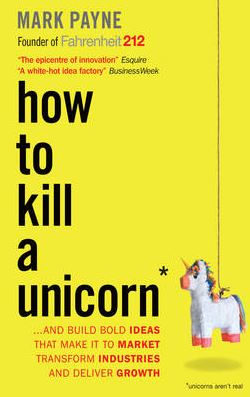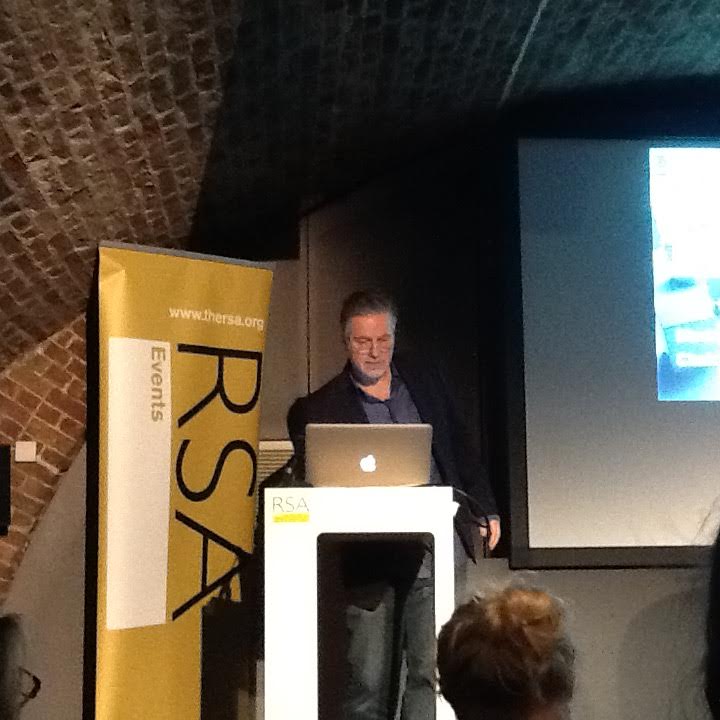What follows is my summary from the notes I made plus others tweets on the event (At the foot of this post are links to other posts summarising various RSA/TED & other talks and articles)
 Giants For Growth @GiantsForGrowth
Giants For Growth @GiantsForGrowth 
@theRSAorg to hear @markf212 explain How To Innovate and Survive #RSAinnovation #howtokillaunicorn
Introduction
"Innovation is the mating dance of art, science and business" is a great quote Mark said right at the start of his lecture
- Mark talked about how the words innovation/innovators have loads of meanings and that in the past innovation was seen as a random, once a decade, lightening bolt type of event.
- Now-a-days its never been a better time to be an innovator ......
- Problems with existing innovation models
- But when Mark looked at the innovation models in use he found that using them innovation fails most of the time - less than 1 in 10 are successful. When innovation wasn't essential to survival and growth then this failure rate was acceptable.. But now it isn't
- So the obvious question is .....
Existing approaches often use an innovation funnel which starts with strategy (where analytics is applied), and which then moves to design (empathise with customers & tease the design) and then finishes with a filter to pick the best ideas. But all of that only delivers a 1 in 10 success rate.
How do we create innovation strategies that are outcome obsessed and which can turn innovation into stuff and succeed far far better than the current 1 in 10 hit rate? Given his experiences helping businesses from a wide variety of markets Mark spotted some patterns from the 1 in 10 ideas that do succeed.
- The solution - address both sides of the problem
- The innovation stuff that makes it to delivery has considers both sides of the problem:
1) the needs of consumers
2) the business needs
Using the picture above to illustrate this - most innovation ideas only aim to solve 1 side of the problem - the 1st hoop - often the consumers - and they may well succeed. But in doing so they completely miss solving the other side of the problem - the 2nd hoop - the business needs.
The 2 sides - the 2 problems to solve to achieve successful innovation generally have nothing to do with each other. And none of the existing innovation models are designed to solve both. The approach Mark has developed does. He calls it Money & Magic - and the energising tension between the 2.
Democracy an example of energizing tension - to be free and governed at the same time #rsainnovation
Some examples
Mark then went onto to describe some specific examples
The new Mini - a unique car for the consumer whose production from the start was designed to be manufactured whilst allowing many different model choices
Coke multi-beverage machines - delivering a much much wider range of drinks whilst doing so in the footfall of the original 4 nozzle machines
Samsung LCD screens in vending machines - addressing customer frustration with "dumb" traditional vending machines by creating interactive ones whilst creating a new market for Samsung to sell its LCD screens into
Mark also mentioned a Big, Fast & Doable matrix that they use
Insights raised by the Q&A
Whether the approach described is dependent on process and/or people?
Mark's answer was its both. He mentioned the 3 M's - Method, Model and Mind
Have you used the 2 sided problem approach in the public sector?
Mark's response was they're looking at some opportunities now - but that work with the public sector will probably require them not to take a 2 sides approach but a 4 or 5 sides approach - so customer an business but also - for example - Government, future generations, tax payers
Have you made any epic failures?
The specific example he gave was of a male grooming foam that would retard beard growth - great idea, technology not available, why would you enter a market and want to shrink it - typical of many innovation ideas created under traditional models
"Create a great idea so it can go off and die"
What if you are ahead of the market?
This was asked by somebody with an email encryption product created some 10 years ago
So using the example of the mail encryption - figure out whether an email carrier would want to embed the product into their service
What about managing risk?
If a business has a portfolio approach to its innovation projects, some short term low risk existing technology & capability ones plus some longer term higher risk - then the portfolio approach "permissions" the business to try some higher risk projects. Obviously if they were all higher risk then the CEO would be saying no as their job is
and putting all the bets in high risk isn't how to achieve that
Is the 2 sided problem approach applicable to all stages of a market's lifecycle?
Tech start up may be an exception. Also the balance between the 2 sides will vary which may mean one is particularly more complex than the other
Also you can often get new value from a company's existing assets
What is the next game changer?
other posts on RSA, TED, other lectures, conferences, others blog posts
2015
this post - how to innovate & survive - by @markf212 (Mark Payne)
18 top tips and thoughts about using #social media to enable #community source = an article by Anatoliy Gruzd PhD & Caroline Haythornthwaite PhD
thinking straight in the age of information overload - by @danlevitin
how to become a soulful organisation - by @fred_laloux
2014
thoughts & headlines from a conference on social media and images
Data Protection & Privacy - 8 issues from an International Conference
escape your social horizon limit & understand more - source = a blog post summarising the work of Jeffrey A. Smith, Miller McPherson & Lynn Smith-Lovin
OECD - challenges for the next 50 years - in an OECD report
Want to help somebody - shut up and listen - by ermesto sirolli
social media & death - 10 things you may not have thought about - #DORS conference
persuasion and power in the modern world and the rise of soft power - UK House of Lords
2013
UK Government Policy Blunders & their common causes - by Anthony King & Ivor Crewe
the development of the U2 spyplane - source = CIA historians Gregory Pedlow & Donald Welzenbach
Guide to Comments (esp. #YouTube) for creators - by @vihartvihart
considering culture and business process improvement - source = an article by Schmiedel, Theresa, vom Brocke, Jan, & Recker
ideas for your organisation from the 2013 99U conference
ideas that may help you attract older volunteers - source = a paper by Brayley, Nadine, Obst, Patricia L., White, Katherine M., Lewis, Ioni M.,Warburton, Jeni, & Spencer, Nancy
physical factors which help people get better quicker - source = a paper by Salonen, Heidi & Morawska, Lidia
a new approach to school and education - by Geetha Narayanan
principles for software to encourage participation - by Gerhard Fischer
guiding principles on designing construction kits - by Mitchel Resnick & Brian Silverman
how to identify the #culture of an organisation
signs of overparenting - source = an article by Locke, Judith, Campbell, Marilyn A., & Kavanagh, David J
making ideas happen - source = a 99U conference
2012
how to spot a liar - by pamela myer
the related world of cyber crime, warfare and industrial espionage - by @mishaglenny
ambiguity, irreverence, commentary & judgement - by lauren zalaznick
measuring happiness - source = talk by jim clifton, jim harter, ben leedle






 Linda Grant
Linda Grant 




No comments:
Post a Comment